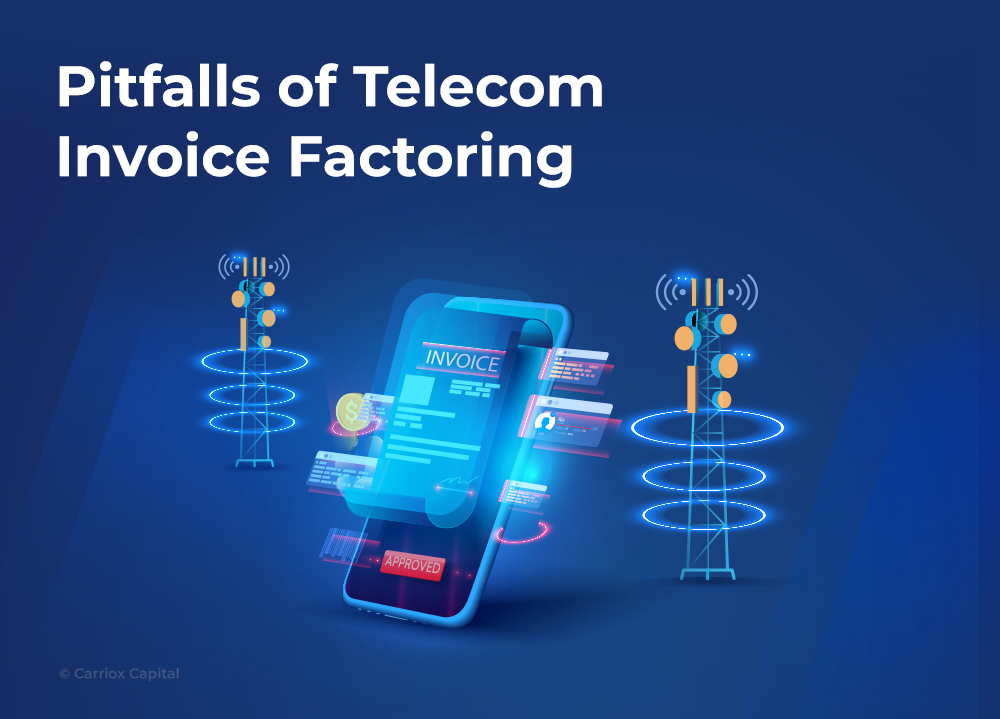Maximizing Returns: Mitigation Strategies for 5 Common Risks Associated with Telecom Invoice Factoring

In the dynamic landscape of cell tower infrastructural financing, where capital investments are pivotal for expansion and maintenance, telecom invoice factoring stands out as a potent financial instrument. This practice entails the sale of accounts receivable to a specialized third-party entity at a discounted rate, offering immediate liquidity to telecom enterprises. Yet, as with any financial domain, invoice factoring is not without its complexities and risks.
In this blog post, we embark on a journey to explore the nuanced terrain of telecom invoice factoring, shedding light on its significance in the realm of cell tower infrastructural financing. We’ll unravel the intricacies of this financial strategy, examining its role in bolstering liquidity for telecom businesses while simultaneously addressing the critical need for risk management.
Top 5 Risks that Hamper Telecom Invoice Factoring
Telecom invoice factoring serves as a cornerstone, providing vital liquidity to propel growth and expansion. However, with its benefits come inherent risks that necessitate proactive management. Let us delve into these risks and explore how telecom businesses can mitigate them effectively in the context of invoice factoring.
Credit Risk
Credit risk looms large in telecom invoice factoring, stemming from the potential for customers to default on payments, jeopardizing the factoring company’s returns. To mitigate this risk, telecom businesses must conduct rigorous credit assessments before engaging with clients. By thoroughly evaluating the creditworthiness of potential customers, businesses can minimize the likelihood of defaults. Diversifying customer portfolios across various industries and geographical regions further spreads the risk, reducing dependence on any single entity.
Mitigation Strategy
Perform thorough credit checks on potential customers before entering into contracts. Establish credit limits based on risk assessments and monitor customer payment behaviours closely. Additionally, consider purchasing credit insurance to protect against customer defaults.
Concentration Risk
The concentration risk arises when a telecom company relies heavily on a limited number of clients for revenue generation. In the context of invoice factoring, this reliance amplifies exposure to defaults and payment fluctuations. To counter concentration risk, businesses must diversify their customer base. By expanding clientele across different industries and regions, telecom companies can mitigate the impact of financial instability on any single client, ensuring more stable revenue streams for cell tower infrastructural financing.
Mitigation Strategy
To address concentration risk, telecom companies must diversify their customer base, reducing reliance on a limited number of clients for revenue generation. By expanding clientele across different industries and regions, telecom companies can mitigate the impact of financial instability on any single client. This diversification strategy ensures more stable revenue streams for cell tower infrastructural financing. Additionally, conducting thorough risk assessments and setting appropriate credit limits for each customer can further mitigate concentration risk by spreading exposure across a broader portfolio of clients.
Regulatory Risk
Operating within a complex regulatory framework, the telecom industry faces regulatory uncertainties that can directly impact invoice factoring arrangements. Changes in billing practices or tariffs can disrupt cash flows and profitability. Mitigating regulatory risk involves staying updated on legislative developments and ensuring compliance with relevant regulations. Proactive engagement with regulatory authorities and legal experts facilitates adaptation to regulatory changes, minimizing disruptions to telecom invoice factoring in cell tower infrastructural financing.
Mitigation Strategy
To mitigate regulatory risk, telecom companies must stay updated on legislative developments and ensure compliance with relevant regulations governing invoice factoring. Proactive engagement with regulatory authorities and legal experts facilitates adaptation to regulatory changes, minimizing disruptions to telecom invoice factoring in cell tower infrastructural financing. Establishing robust compliance processes and conducting regular audits to assess adherence to regulatory requirements can enhance risk management practices and ensure continued compliance with evolving regulatory standards.
Operational Risk
Operational inefficiencies pose a significant threat to invoice factoring, leading to delays in invoice processing and settlements. Such disruptions impact cash flow and profitability, undermining the efficacy of cell tower infrastructural financing. To mitigate operational risk, telecom companies should invest in robust infrastructure and automated systems for invoice management. Implementing stringent internal controls and conducting regular audits help identify and address operational vulnerabilities, ensuring smooth processing and settlement of invoices.
Mitigation Strategy
To mitigate operational risk, telecom companies should invest in robust infrastructure and automated systems for invoice management. Implementing advanced technologies such as cloud-based invoicing platforms and artificial intelligence-powered solutions streamlines invoice processing and settlements, reducing the risk of operational inefficiencies and delays. Additionally, establishing stringent internal controls and conducting regular audits help identify and address operational vulnerabilities, ensuring smooth processing and settlement of invoices. Continuous monitoring of operational performance metrics allows telecom companies to proactively identify and mitigate potential risks, enhancing the efficacy of cell tower infrastructural financing.
Market Risk
Fluctuations in economic conditions, interest rates, and currency exchange rates constitute market risk, impacting the value of invoices and factoring arrangements. Telecom businesses can mitigate market risk by exploring hedging strategies such as forward contracts and options. These instruments provide stability to cash flows generated through invoice factoring, safeguarding the financial interests of telecom enterprises engaged in cell tower infrastructural financing.
Mitigation Strategy
To mitigate market risk, telecom businesses can explore hedging strategies such as forward contracts and options. These financial instruments provide stability to cash flows generated through invoice factoring, safeguarding the financial interests of telecom enterprises engaged in cell tower infrastructural financing. By hedging against fluctuations in economic conditions, interest rates, and currency exchange rates, telecom companies can minimize the impact of market volatility on the value of invoices and factoring arrangements. Regular monitoring of market conditions and proactive adjustment of hedging positions enable telecom companies to effectively manage market risk and maintain financial resilience in the face of uncertainty.
Conclusion
Telecom invoice factoring presents a compelling avenue for bolstering liquidity and enhancing cash flow management within the telecom industry. However, the inherent risks demand vigilant attention and proactive mitigation strategies from businesses. By implementing robust risk management measures such as thorough credit assessments, diversification of customer portfolios, adherence to regulatory compliance, operational enhancements, and utilization of market hedging techniques, telecom enterprises can effectively safeguard their financial interests.
At Carriox Capital, we understand the intricate dynamics of telecom invoice factoring and offer tailored solutions to mitigate risks and optimize returns for our clients. Our team of experts is dedicated to assisting telecom businesses in navigating the complexities of invoice factoring with confidence and resilience.

Arpit Sharma
Arpit Sharma is a Senior Content Writer at Panamax, Inc. with expertise in tech content writing, social media platform management, and more. With a vibrant educational background that includes the amalgamation of electronics and communication engineering and Mass Communication & Journalism, he uses his expertise to curate good content. In his free time, he spends time running marathons, cyclothons, and spending time with his family.

